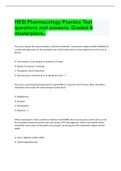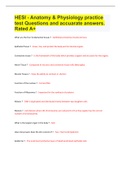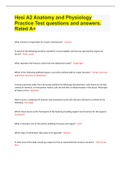House of Excellence Library
We offer questions and answers (graded A+, 100%, and approved) to help you revise and prepare for your assignment.
- 322
- 0
- 4
Community
- Followers
- Following
1 Reviews received
326 items

Advanced Pathophysiology HESI review questions and answer. Predictor questions.
Advanced Pathophysiology HESI review questions and answer. Predictor questions metabolic acidosis - low pH, low HCO3 metabolic alkalosis - high pH, high HCO3 respiratory acidosis - low pH, high CO2 respiratory alkalosis - high pH, low CO2 metabolic acidosis causes - Primary Cause: Addition of large amounts of fixed acids to body fluids; Contributing Causes: Lactic acidosis (circulatory failure), Ketoacidosis (diabetes, starvation), Phosphates and sulfates (Renal dz), Acid inge...
- Exam (elaborations)
- • 14 pages •
Advanced Pathophysiology HESI review questions and answer. Predictor questions metabolic acidosis - low pH, low HCO3 metabolic alkalosis - high pH, high HCO3 respiratory acidosis - low pH, high CO2 respiratory alkalosis - high pH, low CO2 metabolic acidosis causes - Primary Cause: Addition of large amounts of fixed acids to body fluids; Contributing Causes: Lactic acidosis (circulatory failure), Ketoacidosis (diabetes, starvation), Phosphates and sulfates (Renal dz), Acid inge...

Hesi Pathophysiology Practice Exam Questions with accurate rationale answers. Graded A+.
Hesi Pathophysiology Practice Exam Questions with accurate rationale answers. Graded A+ After talking w/ the HCP, a male pt continues to have questions about the results of a prostatic surface antigen (PSA) screening test and asks the nurse how the PSA levels become elevated. The nurse should explain which pathophysiological mechanism? - As the prostate gland enlarges, its cells contribute more PSA in the circulating blood PSA is a glycoprotein found in prostatic epithelial cells, and...
- Exam (elaborations)
- • 10 pages •
Hesi Pathophysiology Practice Exam Questions with accurate rationale answers. Graded A+ After talking w/ the HCP, a male pt continues to have questions about the results of a prostatic surface antigen (PSA) screening test and asks the nurse how the PSA levels become elevated. The nurse should explain which pathophysiological mechanism? - As the prostate gland enlarges, its cells contribute more PSA in the circulating blood PSA is a glycoprotein found in prostatic epithelial cells, and...

HESI PATHO, Patho Hesi 2020/2021 Practice Questions, Pathophysiology HESI. Graded A+.
HESI PATHO, Patho Hesi 2020/2021 Practice Questions, Pathophysiology HESI. Graded A+ Which rationale best supports an older client's risk of complications related to a dysrhythmia? - An older client is intolerant of decreased cardiac output which may cause dizziness and falls In an older client, cardiac output is decreased and a loss of contractility and elasticity reduces systemic and cerebral blood flow, so dysrhythmias, such as bradycardia or tachycardia is poorly tolerated, and i...
- Exam (elaborations)
- • 71 pages •
HESI PATHO, Patho Hesi 2020/2021 Practice Questions, Pathophysiology HESI. Graded A+ Which rationale best supports an older client's risk of complications related to a dysrhythmia? - An older client is intolerant of decreased cardiac output which may cause dizziness and falls In an older client, cardiac output is decreased and a loss of contractility and elasticity reduces systemic and cerebral blood flow, so dysrhythmias, such as bradycardia or tachycardia is poorly tolerated, and i...

NURS 209 Practice Questions HESI (PATHO BOOK). Latest Bank Questions with rationale answers.
NURS 209 Practice Questions HESI (PATHO BOOK). Latest Bank Questions with rationale answers. A decrease in workload, use, pressure, or blood supply appropriately describes: A. physiologic atrophy. B. pathologic atrophy. C. hypertrophy. D. hyperplasia. - B. pathologic atrophy. Pathologic atrophy is a decrease in cell size due to decreased use. Physiologic atrophy usually occurs early in development; for example, the thymus gland atrophies during childhood. Hypertrophy is an increase...
- Exam (elaborations)
- • 88 pages •
NURS 209 Practice Questions HESI (PATHO BOOK). Latest Bank Questions with rationale answers. A decrease in workload, use, pressure, or blood supply appropriately describes: A. physiologic atrophy. B. pathologic atrophy. C. hypertrophy. D. hyperplasia. - B. pathologic atrophy. Pathologic atrophy is a decrease in cell size due to decreased use. Physiologic atrophy usually occurs early in development; for example, the thymus gland atrophies during childhood. Hypertrophy is an increase...

HESI Pharmacology Practice Test questions and answers. Graded A masterpiece,.
HESI Pharmacology Practice Test questions and answers. Graded A masterpiece,. The nurse reviews the new prescription, phenelzine (Nardil), a monoamine oxidase inhibitor (MAOI), for a client with depression on the psychiatric unit. Which information is most important for the nurse to assess? A. Consumption of any alcohol or tyramine rich foods B. Reports of nausea or vomiting C. Therapeutic serum drug levels D. Blood pressure and pulse prior to taking each dose - A The nurse is ad...
- Exam (elaborations)
- • 21 pages •
HESI Pharmacology Practice Test questions and answers. Graded A masterpiece,. The nurse reviews the new prescription, phenelzine (Nardil), a monoamine oxidase inhibitor (MAOI), for a client with depression on the psychiatric unit. Which information is most important for the nurse to assess? A. Consumption of any alcohol or tyramine rich foods B. Reports of nausea or vomiting C. Therapeutic serum drug levels D. Blood pressure and pulse prior to taking each dose - A The nurse is ad...

HESI PHARMACOLOGY PRACTICE QUESTIONS FOR FINAL. Rationale answers provided for all multiple choices. Graded A+.
HESI PHARMACOLOGY PRACTICE QUESTIONS FOR FINAL. Rationale answers provided for all multiple choices. Graded A+ A client is receiving clonidine (Catapres) 0.1 mg/24hr via transdermal patch. Which assessment finding indicates that the desired effect of the medication has been achieved? A. Client denies recent episodes of angina. B. Change in peripheral edema from +3 to +1. C. Client denies recent nausea or vomiting. D. Blood pressure has changed from 180/120 to 140/70. Correct - Catapre...
- Exam (elaborations)
- • 39 pages •
HESI PHARMACOLOGY PRACTICE QUESTIONS FOR FINAL. Rationale answers provided for all multiple choices. Graded A+ A client is receiving clonidine (Catapres) 0.1 mg/24hr via transdermal patch. Which assessment finding indicates that the desired effect of the medication has been achieved? A. Client denies recent episodes of angina. B. Change in peripheral edema from +3 to +1. C. Client denies recent nausea or vomiting. D. Blood pressure has changed from 180/120 to 140/70. Correct - Catapre...

HESI - Anatomy & Physiology practice test Questions and accuarate answers. Rated A+
HESI - Anatomy & Physiology practice test Questions and accuarate answers. Rated A+ What are the four fundamental tissues ? - Epithelial,connective,muscle,nervous Epithelial Tissue ? - Cover, line, and protect the body and its internal organs. Connective tissue ? - Is the framework of the body which provides support and structure for the organs. Nerve Tissue ? - Composed of neurons and connective tissue cells (Neuroglia). Muscle Tissues ? - Have the ability to contract or shorte...
- Package deal
- Exam (elaborations)
- • 14 pages •
HESI - Anatomy & Physiology practice test Questions and accuarate answers. Rated A+ What are the four fundamental tissues ? - Epithelial,connective,muscle,nervous Epithelial Tissue ? - Cover, line, and protect the body and its internal organs. Connective tissue ? - Is the framework of the body which provides support and structure for the organs. Nerve Tissue ? - Composed of neurons and connective tissue cells (Neuroglia). Muscle Tissues ? - Have the ability to contract or shorte...

HESI Pharmacology Practice Exam Questions with 100 % accurate answers, Graded A+
HESI Pharmacology Practice Exam Questions with 100 % accurate answers, Graded A+ Following the administration of sublingual nitroglycerin to a client experiencing an acute anginal attack, which assessment finding indicates to the nurse that the desired effect has been achieved? A. Client states chest pain is relieved B. Client's pulse decreases from 120 to 90 C. Client's systolic blood pressure decreases from 180 to 90 D. Clients SaO2 level increases from 92% to 96% - A. nitroglyceri...
- Exam (elaborations)
- • 22 pages •
HESI Pharmacology Practice Exam Questions with 100 % accurate answers, Graded A+ Following the administration of sublingual nitroglycerin to a client experiencing an acute anginal attack, which assessment finding indicates to the nurse that the desired effect has been achieved? A. Client states chest pain is relieved B. Client's pulse decreases from 120 to 90 C. Client's systolic blood pressure decreases from 180 to 90 D. Clients SaO2 level increases from 92% to 96% - A. nitroglyceri...

HESI Pharmacology Practice Exam questions with 100% accurate answers. Graded A+.
HESI Pharmacology Practice Exam questions with 100% accurate answers. Graded A+ Which nursing action is the priority when administering chelation therapy for a toddler-age client? 1 Assessing vital signs 2 Monitoring urine output 3 Conducting a behavioral assessment 4 Providing education to reduce lead exposure - 2 A 67-year-old client has tested positive for influenza A. The client also has asthma. Which drug would the nurse recommend be avoided in this client? 1 Ribavirin 2 Zana...
- Exam (elaborations)
- • 26 pages •
HESI Pharmacology Practice Exam questions with 100% accurate answers. Graded A+ Which nursing action is the priority when administering chelation therapy for a toddler-age client? 1 Assessing vital signs 2 Monitoring urine output 3 Conducting a behavioral assessment 4 Providing education to reduce lead exposure - 2 A 67-year-old client has tested positive for influenza A. The client also has asthma. Which drug would the nurse recommend be avoided in this client? 1 Ribavirin 2 Zana...

Hesi A2 Anatomy and Physiology Practice Test questions and answers. Rated A+
Hesi A2 Anatomy and Physiology Practice Test questions and answers. Rated A+ What mineral is responisble for muscle contractions? - Calcium In which of the following locations would the urinary bladder and internal reproductive organs be found? - Pelvic cavity What separates the thoracic cavity from the abdominal cavity? - Diaphragm Which of the following epithelial types is correctly matched with its major function? - Simple columnar epithelium-secretion or absorption A tissu...
- Package deal
- Exam (elaborations)
- • 3 pages •
Hesi A2 Anatomy and Physiology Practice Test questions and answers. Rated A+ What mineral is responisble for muscle contractions? - Calcium In which of the following locations would the urinary bladder and internal reproductive organs be found? - Pelvic cavity What separates the thoracic cavity from the abdominal cavity? - Diaphragm Which of the following epithelial types is correctly matched with its major function? - Simple columnar epithelium-secretion or absorption A tissu...

A-level FURTHER MATHEMATICS Paper 3 Mechanics
Great